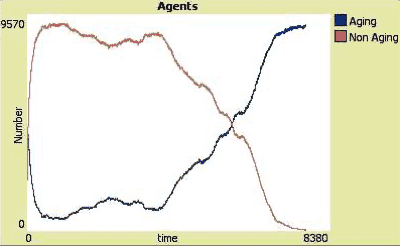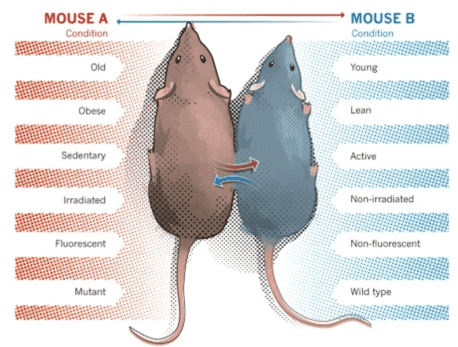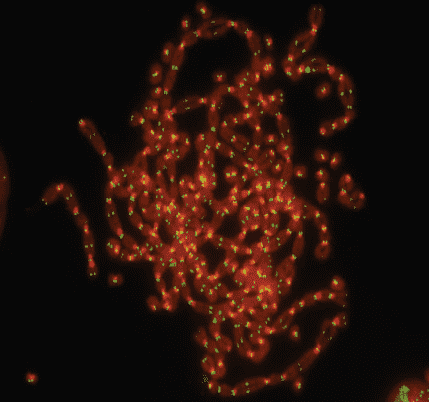-
Do you recall when experts cautioned that it would take a minimum of 10 years to create a new vaccine at the onset of the pandemic? It’s common for experienced individuals to rely solely on their past experiences, disregarding any new factors. Given the global impact of the virus and the significant amount of funding allocated towards finding a vaccine, it was evident that the prediction of a 10-year timeline was entirely baseless.
It is possible that a breakthrough in finding the cure for aging could occur suddenly, similar to how advancements in AI have emerged overnight. Based on the substantial funding that has been dedicated to this research over the past few years, I am optimistic that a cure will be developed within the next 5-10 years.
-
Mike Best commented on The evolution of aging 12 months ago
I do agree the old way of thinking about aging held up progress. If not for that we likely would have approved treatments already fine tuned that result in much better healthspans and we would be a lot closer to figuring out a way to keep people from ever reaching the current state of old age in the first place. Not sure if I will see it in my lifetime but I think once we figure it out there will be no age limit. We will go from our limit of around 120 to death from old age being eliminated. I dont buy this stuff about the age limit being first increased to 150 and 200 etc.
-
I guess most people would think as aging kicking on in their mid-30s if they are in decent shape because that is the point most physically decline even if they continue to exercise.
Many individuals previously held the belief that the Earth was flat and that aging was a result of the accumulation of damage simply because those were the observations made by their senses. It required significant effort from scientists to persuade them otherwise.
Multicellular organisms die of old age when a vital organ fails because damage is no longer repaired. There are several reasons why systemic damage may not be repaired, with programmed stem cell elimination being one of them.
-
Mike Best commented on The evolution of aging 12 months ago
I guess most people would think as aging kicking on in their mid-30s if they are in decent shape because that is the point most physically decline even if they continue to exercise. I see your point on when it really starts though.
I do wonder what is limiting lifespan (in mice/rat experiments) though beyond the signaling of proteins etc. With enough age does lipofuscin and other things that are extra cellular cause enough problems as to assure death even if most factors in the blood are signaling for more youthful repair. The plateau in DNAm age is interesting also.
Are 110+ year old people mostly just dying because of stem cell exhaustion (not sure if this is the right term) that results in their hearts giving out basically or could something else be adjusted/treated so that the heart continued to replace the cells it needed to function.
-
It is true that the proteome programmatically changes with age. However, I think we have to distinguish between the occurrences of the typical signs of aging and the underlying biological process. Aging starts 4.5-10.5 days after the sperm and the egg cell unite and from then on the aging process decelerates until it comes to a complete stop.
This is from Steve Horvath:
In young animals, DNAm age moves faster than physical time whereas in very old rats DNAm age enters a virtual plateau.
Take hair graying as an example. Recent research has revealed that the discoloration of hair is not caused by the natural deterioration of melanocytes, which are responsible for pigment-producing hair. The change in behavior of melanocyte stem cells is the actual cause, and it could be connected to the programmed elimination of stem cells. The process of hair graying actually begins long before the first strand even appears, and is determined by a genetic program. When your hair turns completely white, this programmed aging process can be considered complete.
It has been evident that the theory of aging based on damage cannot fully account for hair graying, as there are significant variations among individuals in terms of when this process begins. This article explains why scientists have long overlooked the most apparent empirical data.
-
Mike Best commented on The evolution of aging 12 months ago
Aging is definiely programmed into us imo. How the proteome has large changes according to a study at approximately 34, 60 and 79 years of age is interesting also. It seems to kind of align with when a lot of people claim they started really feeling the aging.
-
Michael Pietroforte wrote a new post 12 months ago
In my previous post, I outlined the new telomere theory of aging. One of the objections against this theory is that it claims that aging is genetically programmed, which appears to contradict the central dogma of neo-Darwinism, which states that evolution tries to maximize the replication fitness of individuals. Aging obviously reduces the fitness of individuals in their ability to reproduce because it limits the available time to produce offspring. Thus, supporters that link aging to programmed traits usually refer to group selection and claim the aging of individuals gives a population or species a competitive advantage. However, the concept of group selection raises a red flag for the neo-Darwinist.

-
My prediction is the change wont be as large as the e5 change there.
That’s quite possible. I’ve to add the Conboys do not rule out that anti-aging factors in young blood exist and Horvath does not rule out that pro-aging factors exist in old blood.
-
Mike Best commented on The (new) telomere theory of aging 1 year ago
Someone on redditt says the Conboys are doing a study now that will include Horvath clock measurements. My prediction is the change wont be as large as the e5 change there.
I tend to agree about senescent cell removal maybe being the best current strategy. That seems to reset a lot of things associated with aging back to more youthful levels.
-
The primary issue is that Horvath and the Conboys are utilizing different biomarkers. Horvath primarily concentrates on his epigenetic clocks and lifespan, while the Conboys focus on tissue-dependent metrics such as muscle repair, fibrosis reduction, and myogenic proliferation. I can’t recall reading a Conboy paper that discusses epigenetic clocks, which is unfortunate.
In my opinion, E5 or plasma replacement may not be the optimal solution. The improvements in lifespan and healthspan that can be achieved are moderate at most. It is likely that stem cell therapies have more potent effects, but their execution can be more challenging.
Senolysis appears to be the most favorable option in the short term. Potential solutions for the long term could be provided by gene therapies and partial reprogramming.
-
Mike Best commented on The (new) telomere theory of aging 1 year ago
Havent found that specific interview yet but my view is both things can work to an extent. Katcher seems to think no dilution is needed for e5 to work effectively though. I think the Conboys are maybe a little hard headed thinking dilution alone can be just as effective as adding things from young blood. They wont say what they are making sure they get for e5 from the young pigs blood but looking at some things mentioned in the process patent I would think Klotho is possibly one of the proteins they are after.
Do you think stem cell therapy combined with something like e5 treatments could possibly produce a mouse/rat that has a lifespan quite a bit longer than the top lifespans so far with calorie restriction and things like Rapamycin?
-
I just read a relatively new paper from Steve Horvath who measured the epigenetic age of Katcher’s rats. The authors of the paper seem to suggest the existence of anti-aging factors, as they attribute the rejuvenation effects to factors found in young rat plasma:
It has been reported that plasma dilution improves cognition and attenuates neuroinflammation in old mice, which suggests that dilution of putative circulating deleterious factors in old mice may be beneficial (33), although there is no documented evidence that plasma dilution increases lifespan in mice or any other mammals. It seems unlikely that the blood dilution that took place in our rats after i.p. plasma injection every other week, may have played a role in the changes reported here. Besides, after 30 months of age, the treated rats began to die in spite of the fact that we continued injecting plasma until their natural death.
The Conboys appear to have a differing view , as they believe that the dilution effects are crucial and, therefore the removal of pro-aging factors.
Our data demonstrate that a single NBE suffices to meet or exceed the rejuvenative effects of enhancing muscle repair, reducing liver adiposity and fibrosis, and increasing hippocampal neurogenesis in old mice, all the key outcomes seen after blood heterochronicity.
NBE stands for “neutral” age blood exchange.
-
Mike Best commented on The (new) telomere theory of aging 1 year ago
Not off hand but I will try and find a link in the morning. My guess is they had identified a few things they really wanted and filtered by size to get them in addition to the rest of the factors that came with them.
-
Do you have a link to the interview?
I concur that a significant advancement in geroscience is within reach, and it may occur suddenly, just like the advent of AI. Moreover, the crucial discovery may originate from an individual who was not previously recognized.
-
Mike Best commented on The (new) telomere theory of aging 1 year ago
I am curious ehat E5 is myself or at least what he was after when he filtered the blood for the factors. He did say in an interview that they were using things from young blood but in even higher concentrations than would be present in young blood normally and Akshay I think made a comment they didnt need to dilute the old blood first because the amounts upregulated their targets enough without having to do that.
It appears we are close to getting humans where they can age more like something like a crocodile with a short period of majore decline at the end but getting most people past like 95-100 is a whole bigger issue. Getting 80 year olds looking like in shape 50 year olds would be a major thing though.
-
Mike, thanks!
Katcher’s rats simply died because of old age. It is not entirely clear what E5 is, but I guess he is only filtering pro-geronic signals from the blood plasma. However, local signaling does not require blood. For instance, senescent cells can directly reprogram mitotic cells via SCAFs. And yes, you are right. The Hayflick limit continues to eliminate stem cells. Thus, filtering blood plasma can only slow aging.
-
Mike Best commented on The (new) telomere theory of aging 1 year ago
An interesting look at why we age. I dont know too much on this subject except some pretty basic stuff.
What is your guess on what killed most of Katcher’s rats at the end? Just running out of good stem cells basically? Is there a limit on stem cells late in life even if the signalling is reset to a younger state?
-
Michael Pietroforte wrote a new post 1 year ago
Telomere shortening has been linked to aging for quite a while. In recent years, new data, particularly regarding the influence of senescent cells and the role of “stem cell depletion” in aging, have shed new light on the role of the telomere countdown timer. I recommend reading my last post about the top five telomere myths before you continue here because I will build on the terminology I developed there.

-
Michael Pietroforte edited the doc Transhumanism websites 1 year, 3 months ago
-
Michael Pietroforte wrote a new post 1 year, 3 months ago
Let me assure you that my intent in this article is not to refute any empirical data or established theories about telomeres. Instead, I will explain why I believe that the historical course of scientific discoveries and an outdated paradigm about the biological cause of aging have led to the use of inaccurate language in describing the roles and functions of telomeres.

- Load More
© hplus.club 2024
